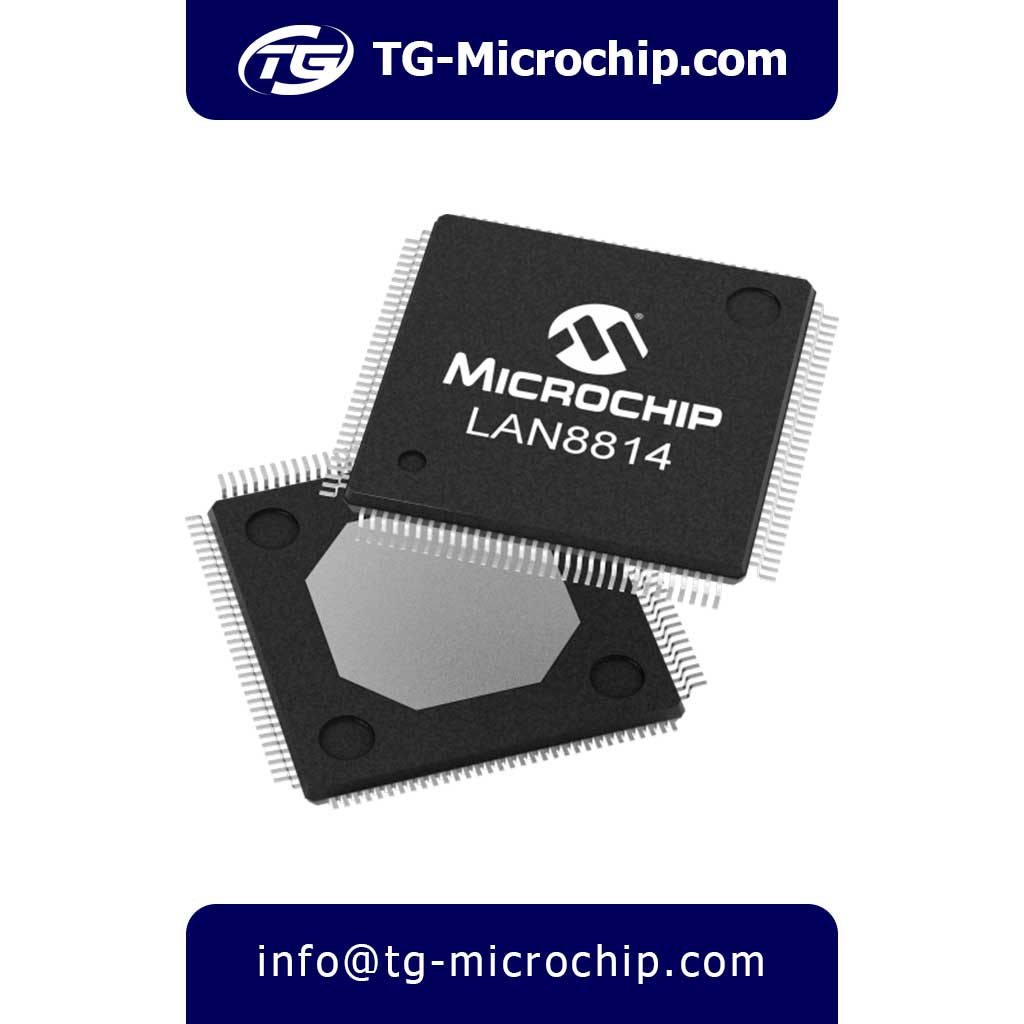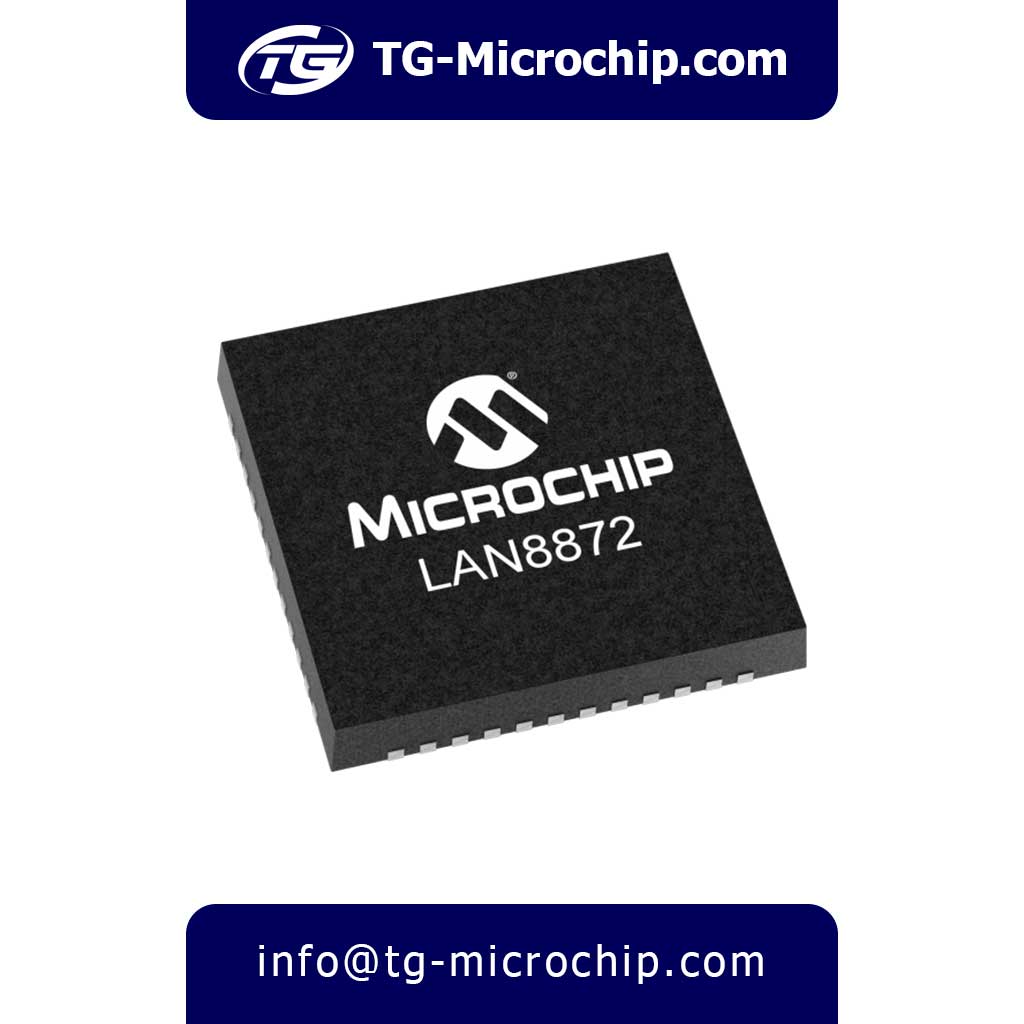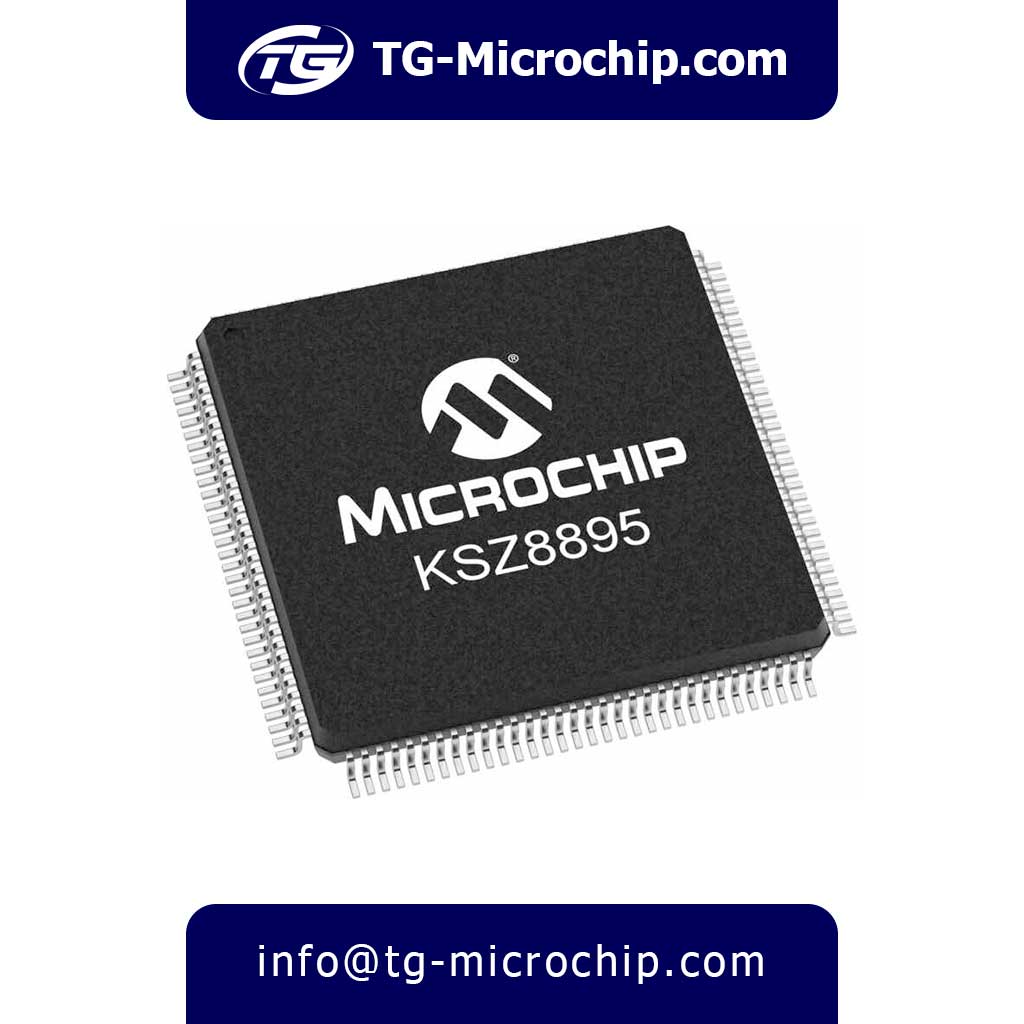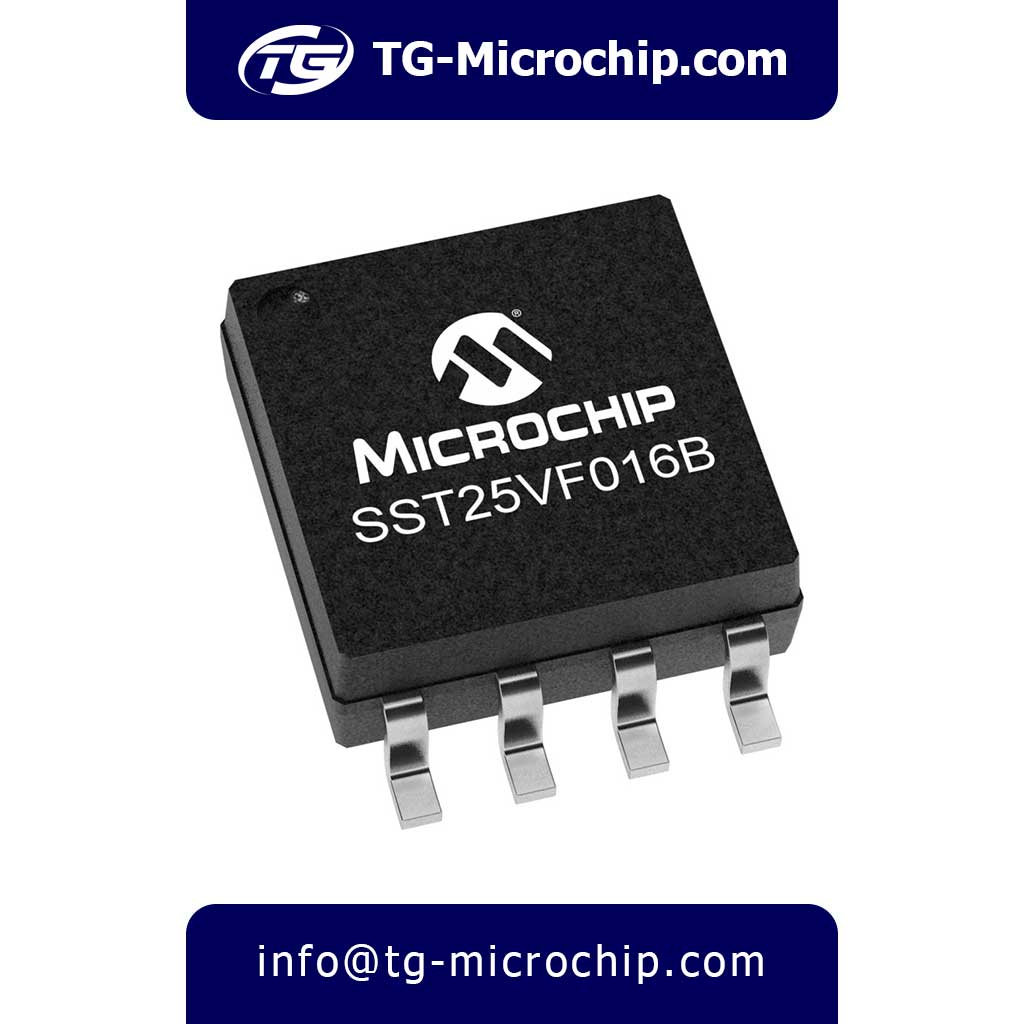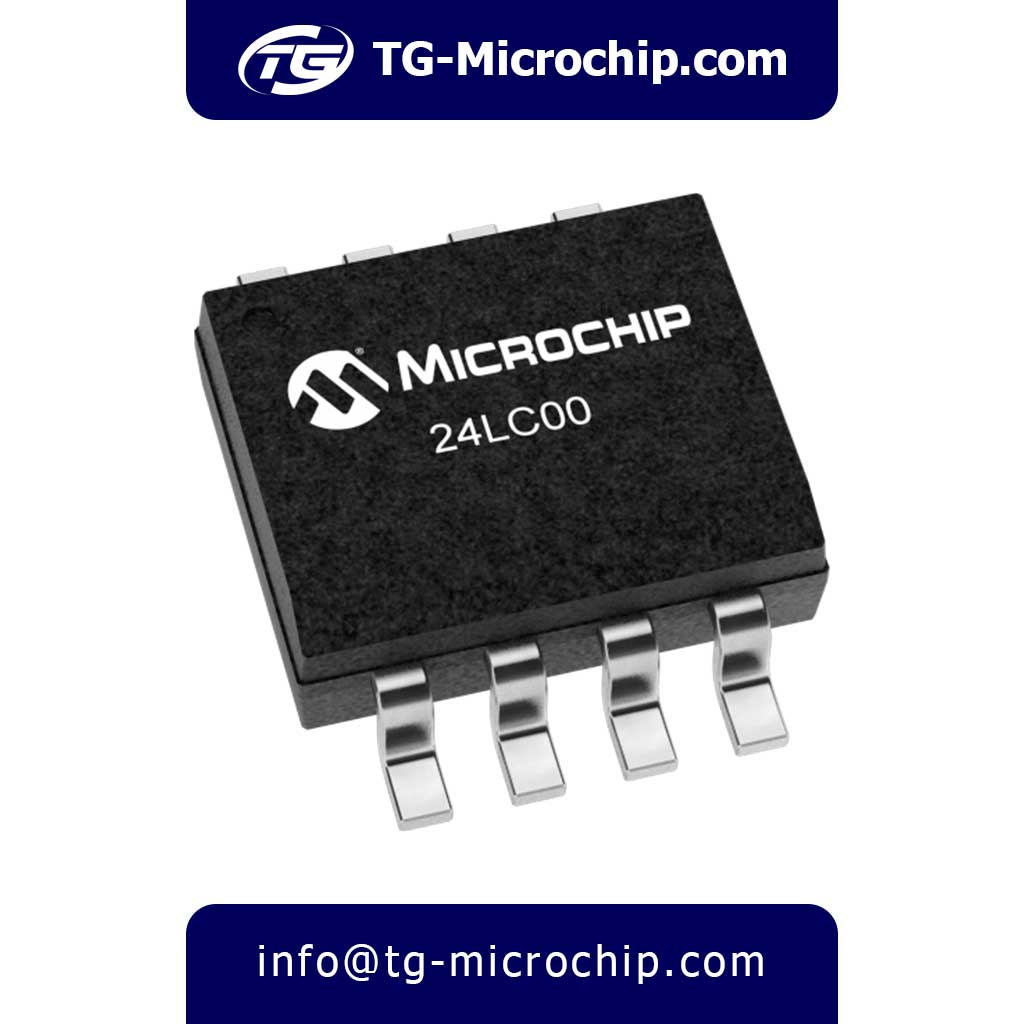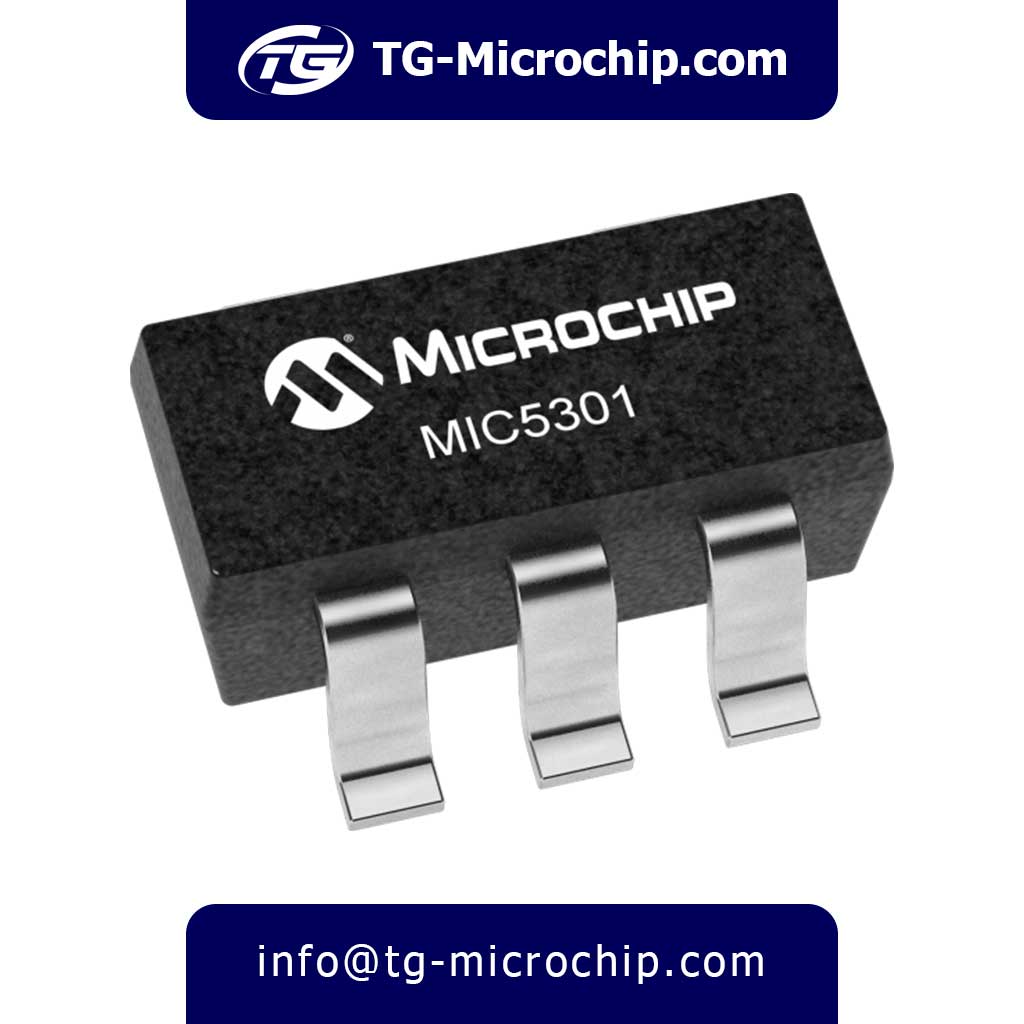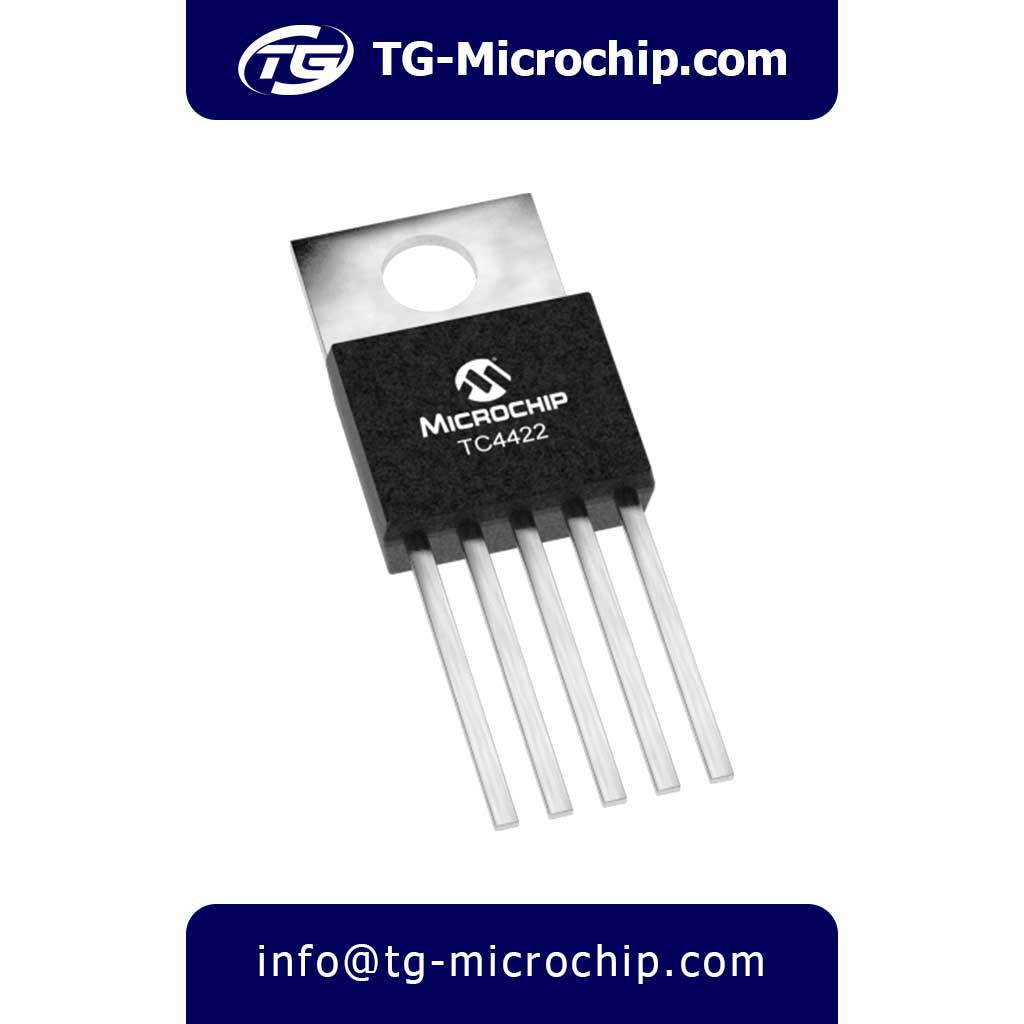For order or price inquiry of LAN8814-V/ZMXC1 Microchip Technology Please click on Buy Order button and fill the RFQ form we will check out inventory and offer you our best price.
Quick Access
About
The LAN8814-V/ZMXC1 is a quad-port Gigabit Ethernet physical layer (PHY) transceiver designed for high-performance networking applications. It supports triple-speed operation (10/100/1000 Mbps) over standard CAT-5, CAT-5e, and CAT-6 UTP cables, making it versatile for both legacy and modern network infrastructures. The device integrates advanced interfaces like QSGMII and Q-USGMII v1.3, enabling efficient chip-to-chip communication with four Gigabit MACs through a single serialized link per direction. This reduces board complexity and cost while maintaining high data throughput.
A standout feature of the LAN8814 is its precision timing support, including IEEE 1588v2 Precision Time Protocol (PTP) and Synchronous Ethernet (SyncE), which are critical for time-sensitive applications like industrial automation and telecom infrastructure. The PHY also complies with Time-Sensitive Networking (TSN) standards (IEEE 802.3-2018), offering frame preemption and low-latency communication for deterministic networks. Additionally, its ±8ns PTP accuracy ensures synchronization in distributed systems, while SyncE support aids in clock distribution across networks.
The LAN8814 excels in power efficiency and integration. It includes an on-chip LDO controller to simplify power supply design, requiring only a single 2.5V or 3.3V input to generate the 1.1V core voltage 5. Energy-Efficient Ethernet (EEE) compliance (802.3az) reduces power consumption during low traffic, saving up to 20mW per port for shorter cable runs. Diagnostic tools like LinkMD® TDR-based cable diagnostics and loopback modes streamline system debugging, while automatic MDI/MDIX crossover eliminates manual cable configuration.
Packaged in a 128-pin TQFP-EP (14×14 mm) RoHS-compliant housing, the LAN8814 is built for rugged environments, operating across an industrial temperature range (-40°C to +85°C). Its compact design integrates termination resistors for differential pairs, further saving PCB space. The PHY also offers 24 programmable GPIOs and configurable LED outputs for link/activity indication, enhancing system flexibility.
Target applications span industrial switches, enterprise routers, FPGA-based systems, and cellular infrastructure, where reliability and timing precision are paramount. The LAN8814’s blend of high-speed performance, low power, and robust feature set makes it a preferred choice for embedded networking solutions in demanding environments.
Key Features
- Quad-Port Gigabit Ethernet PHY
- 4 independent 10/100/1000 Mbps Ethernet transceivers
- Supports 10BASE-T, 100BASE-TX, and 1000BASE-T standards
- Advanced Interface Support
- QSGMII (Quad Serial Gigabit Media Independent Interface) v1.3
- Q-USGMII (Quad Universal Serial Gigabit Media Independent Interface)
- Precision Timing Protocols
- IEEE 1588v2 Precision Time Protocol (PTP) hardware support
- Synchronous Ethernet (SyncE) capability
- <100ns synchronization accuracy
- Cable Diagnostics
- LinkMD® TDR-based cable diagnostics
- Cable length estimation
- Fault detection (open/short)
- Power Management
- Energy Efficient Ethernet (EEE) 802.3az compliance
- On-chip LDO controller for power supply integration
- Multiple power domains for optimized consumption
- Signal Integrity Features
- Adaptive equalization
- Crosstalk cancellation
- Baseline wander correction
- Auto-Negotiation and Configuration
- Automatic speed and duplex detection
- Automatic MDI/MDIX crossover
- Programmable LED outputs for status indication
- Industrial Robustness
- Extended temperature range (-40°C to +85°C)
- ±8kV HBM ESD protection
- ±2kV CDM ESD protection
- Diagnostic and Test Features
- Loopback modes (remote and local)
- PRBS pattern generation and detection
- Built-in self-test capabilities
- Physical Layer Specifications
- Compliant with IEEE 802.3, 802.3u, 802.3ab standards
- Supports both full-duplex and half-duplex operation
- Integrated termination resistors
- GPIO and Control Interface
- 24 programmable GPIO pins
- MIIM (MDC/MDIO) management interface
- SPI interface for configuration
- Packaging
- 128-pin TQFP-EP package (14mm × 14mm)
- Exposed thermal pad for enhanced heat dissipation
- 0.5mm pin pitch
- Advanced Ethernet Features
- Jumbo frame support (up to 10KB)
- VLAN tag detection and processing
- Flow control (802.3x)
- Clock Management
- Multiple clock input options
- Clock synchronization outputs
- Integrated clock recovery
- Compliance and Certifications
- RoHS 3 compliant
- Halogen-free
- Industrial EMI/EMC performance
- Additional Functionality
- Wake-on-LAN support
- Link status detection
- Programmable interrupt outputs
Applications
Industrial Automation & Industry 4.0
- Programmable Logic Controllers (PLCs)
- Enables real-time communication between PLCs and I/O modules with IEEE 1588v2 PTP for synchronization.
- Supports deterministic protocols like PROFINET RT/IRT and EtherCAT via TSN features (frame preemption, time-aware shaping).
- Robotics & Motion Control
- Provides low-latency, high-bandwidth links for robotic arms and servo drives.
- SyncE ensures precise coordination in multi-axis systems.
- Machine Vision Systems
- Handles high-throughput data from industrial cameras for quality inspection.
- Industrial IoT (IIoT) Gateways
- Aggregates sensor data with PTP timestamping for time-sensitive analytics.
Telecommunications & Networking
- 5G Fronthaul/Midhaul Equipment
- SyncE maintains phase alignment in 5G base stations and switches.
- Optical Line Terminals (OLTs)
- Interfaces with GPON/XGS-PON systems for fiber-to-the-home (FTTH) networks.
- Network Interface Cards (NICs)
- Enables high-density port aggregation in data center NICs via QSGMII.
Automotive & Transportation
- Advanced Driver Assistance Systems (ADAS)
- Transmits LiDAR and camera data over automotive Ethernet backbones.
- In-Vehicle Infotainment (IVI)
- Supports gigabit multimedia streaming and diagnostics.
- Zonal Architectures
- Replaces legacy CAN/CAN FD with Ethernet for centralized vehicle control.
Data Centers & Enterprise Networks
- Top-of-Rack (ToR) Switches
- Quad-port integration reduces PCB space in high-density switches.
- Storage Area Networks (SANs)
- Ensures reliable PHY-layer links for NAS/SAN storage systems.
Energy & Smart Grid
- Smart Substations (IEC 61850)
- PTP synchronizes protection relays and circuit breakers.
- Phasor Measurement Units (PMUs)
- Enables microsecond-level grid monitoring for wide-area control.
Aerospace & Defense
- Avionics (AFDX Networks)
- Meets stringent EMI/EMC requirements for aircraft communication.
- Military Ground Vehicles
- Ruggedized Ethernet for command/control systems.
Medical & Healthcare
- Medical Imaging (MRI/CT Scanners)
- High-bandwidth data transfer for DICOM-compliant networks.
- Patient Monitoring Systems
- SyncE ensures real-time vital sign data accuracy.
Broadcast & Professional AV
- IP-Based Broadcast Studios (SMPTE ST 2110)
- Sub-microsecond PTP sync for multi-camera production.
- Digital Signage Networks
- Delivers 4K/8K video streams with jitter-free timing.
Emerging Applications
- Edge Computing Gateways
- Combines TSN and PTP for latency-sensitive edge analytics.
- Smart Cities (Traffic/Utility Monitoring)
- Robust industrial-grade PHY for outdoor deployments.
Key Cross-Industry Benefits
- Deterministic Latency: Critical for real-time control (TSN/PTP).
- Industrial Durability: -40°C to +85°C operation.
- Scalability: QSGMII reduces MAC-to-PHY pin count.
Advantages
- Simplified System Design
- Reduces board complexity by integrating four PHYs in a single chip
- Eliminates need for external termination resistors
- Minimizes component count through on-chip LDO controller
- Enhanced Power Efficiency
- Significantly lowers power consumption compared to discrete PHY solutions
- Achieves up to 20mW per port power savings with EEE (Energy Efficient Ethernet)
- Optimized power architecture reduces thermal management requirements
- Superior Timing Precision
- Enables sub-100ns clock synchronization accuracy for time-sensitive applications
- Provides better timing performance than software-based PTP implementations
- Maintains superior clock synchronization in noisy environments
- Improved Network Reliability
- Delivers more stable performance across industrial temperature ranges
- Offers better signal integrity through advanced equalization and crosstalk cancellation
- Ensures more robust operation in electrically noisy environments
- Reduced Development Time
- Simplifies firmware development with comprehensive register set and documentation
- Accelerates time-to-market with proven reference designs
- Minimizes debugging time through built-in diagnostic capabilities
- Cost Optimization
- Lowers total system cost by reducing external component requirements
- Decreases power supply complexity with integrated voltage regulation
- Reduces manufacturing costs through single-chip quad-port integration
- Enhanced Flexibility
- Supports wider range of applications through industrial temperature rating
- Provides more configuration options through programmable GPIOs
- Enables easier system integration with multiple interface options
- Better Maintenance Capabilities
- Simplifies troubleshooting with advanced cable diagnostics
- Reduces field service requirements through robust fault detection
- Enables predictive maintenance through comprehensive status monitoring
- Superior Signal Performance
- Maintains better signal integrity over longer cable runs
- Provides more consistent performance across varying cable quality
- Delivers more reliable operation in challenging EMI environments
- Future-Proof Design
- Ensures longer product lifecycle through compliance with latest standards
- Provides better upgrade path with support for emerging protocols
- Offers more design headroom for evolving network requirements
- Space Savings
- Reduces PCB footprint by 60% compared to discrete PHY solutions
- Enables more compact product designs through high integration
- Simplifies layout with optimized pinout arrangement
- Improved System Integration
- Works better with FPGAs through standardized interfaces
- Provides smoother integration with various MAC implementations
- Enables cleaner system architecture through reduced external components
- Enhanced Quality of Service
- Delivers more deterministic performance for time-critical applications
- Provides better traffic management through advanced flow control
- Ensures more consistent throughput under varying network conditions
- Simplified Compliance Testing
- Reduces certification effort with built-in standards compliance
- Minimizes EMI/EMC testing challenges through optimized design
- Simplifies regulatory approval process
- Long-Term Reliability
- Extends product lifespan through industrial-grade construction
- Reduces field failures with robust ESD protection
- Maintains stable performance over extended operational periods
Specifications
| Category | Specification |
|---|---|
| General Information | |
| Manufacturer | Microchip Technology |
| Series | LAN8814 |
| Part Number | LAN8814-V/ZMXC1 |
| Product Category | Ethernet ICs – Physical Layer (PHY) Transceivers |
| Product Type | Quad-Port Gigabit Ethernet PHY |
| Status | Active (Production) |
| Electrical Specifications | |
| Data Rate | 10BASE-T, 100BASE-TX, 1000BASE-T (Auto-Negotiation) |
| MAC Interface | QSGMII (Quad Serial Gigabit Media Independent Interface) v1.3 |
| Supply Voltage | – Core: 1.05V to 1.21V (Typ. 1.2V) – I/O: 2.375V to 2.75V, 3.135V to 3.63V |
| Power Consumption | <1.5W per port (1000BASE-T Full Duplex) |
| ESD Protection | ±8kV (HBM), ±2kV (CDM) |
| Signal Integrity | |
| Receiver Sensitivity | 10BASE-T: ±22mV min. 100BASE-TX: ±200mV min. 1000BASE-T: Compliant with IEEE 802.3ab |
| Jitter Performance | <0.5UI (1000BASE-T) |
| Physical Characteristics | |
| Package Type | 128-TQFP Exposed Pad (14mm × 14mm × 1.0mm) |
| Pin Pitch | 0.5mm |
| Lead Count | 128 |
| Mounting Style | Surface Mount (SMD) |
| Operating Temperature | -40°C to +85°C (Industrial Grade) |
| Storage Temperature | -65°C to +150°C |
| Functional Features | |
| Integrated Functions | – 4x Gigabit Ethernet PHY Transceivers – IEEE 1588v2 Precision Time Protocol – Synchronous Ethernet (SyncE) – Energy Efficient Ethernet (EEE) 802.3az – Cable Diagnostics (LinkMD® TDR) – Automatic MDI/MDIX Crossover |
| Wake-on-LAN | Supported |
| Protocol Compliance | |
| Standards | IEEE 802.3, 802.3u, 802.3ab, 802.3az, 802.1AS, 802.1Qav |
| EMI/EMC Compliance | EN 55032, FCC Part 15 Class B |
| Manufacturing & Quality | |
| RoHS Compliance | RoHS 3 (2015/863/EU) |
| Halogen-Free | Yes |
| Moisture Sensitivity Level (MSL) | MSL 3 (168 hours floor life) |
| Applications | Industrial Ethernet Switches, Automotive Infotainment, Network Interface Cards, FPGA-Based Systems |
Comparison with Similar Components
1. LAN8814-V/ZMXC1 vs. LAN8804-V/ZMXC1 (Microchip)
Key Differences:
| Parameter | LAN8814-V/ZMXC1 | LAN8804-V/ZMXC1 |
|---|---|---|
| Timing Features | IEEE 1588v2 PTP, SyncE, TSN | Basic IEEE 802.3 (No PTP/SyncE) |
| Interface | QSGMII + Q-USGMII v1.3 | Standard QSGMII |
| Power Efficiency | 1.1W/port (EEE support) | 1.3W/port (No EEE) |
| Diagnostics | LinkMD® TDR + PRBS | Basic cable diagnostics |
Summary:
The LAN8814 adds precision timing (PTP/SyncE) and lower power consumption, making it superior for industrial TSN networks, while the LAN8804 suits simpler multi-port designs without timing needs.
Recommendation:
- LAN8814 for smart factories, 5G fronthaul.
- LAN8804 for enterprise switches without timing sync.
2. LAN8814-V/ZMXC1 vs. VSC8514 (Microsemi)
Key Differences:
| Parameter | LAN8814-V/ZMXC1 | VSC8514 |
|---|---|---|
| TSN Support | Full (Frame preemption, time-aware) | None |
| Latency | <100ns (PTP) | ~200ns |
| Package Density | 128-TQFP (14×14mm) | 128-TQFP (14×14mm) |
| Voltage Range | 1.05V–3.63V (Multi-domain) | 1.2V–3.3V |
Summary:
The LAN8814’s TSN capabilities and lower latency outperform the VSC8514 for deterministic networks, though both share similar port density.
Recommendation:
- LAN8814 for Industry 4.0, robotic control.
- VSC8514 for legacy gigabit switches.
3. LAN8814-V/ZMXC1 vs. AR8035 (Qualcomm)
Key Differences:
| Parameter | LAN8814-V/ZMXC1 | AR8035 |
|---|---|---|
| Environment | Industrial (-40°C to +85°C) | Commercial (0°C to +70°C) |
| ESD Protection | ±8kV HBM, ±2kV CDM | ±4kV HBM |
| Protocol Support | PTP, SyncE, TSN | Basic 802.3 |
| Signal Integrity | Adaptive equalization + crosstalk cancellation | Basic equalization |
Summary:
The LAN8814 dominates in harsh environments and time-sensitive applications, while the AR8035 is limited to benign office networks.
Recommendation:
- LAN8814 for oil/gas, outdoor telecom.
- AR8035 for consumer routers.
4. LAN8814-V/ZMXC1 vs. DP83867IRPAP (TI)
Key Differences:
| Parameter | LAN8814-V/ZMXC1 | DP83867IRPAP |
|---|---|---|
| Port Count | 4 | 1 |
| Timing Accuracy | <100ns (PTP) | ~200ns (PTP) |
| Package | 128-TQFP (14×14mm) | 64-HTQFP (10×10mm) |
| Diagnostics | TDR-based (LinkMD®) | Basic loopback tests |
Summary:
The LAN8814 offers 4× port density and superior timing, while the DP83867 is compact for single-port endpoints.
Recommendation:
- LAN8814 for high-density timing-critical switches.
- DP83867 for PLCs, sensors.
5. LAN8814-V/ZMXC1 vs. KSZ9031RNX (Microchip)
Key Differences:
| Parameter | LAN8814-V/ZMXC1 | KSZ9031RNX |
|---|---|---|
| TSN Readiness | Full support | None |
| Power | 1.1W/port (EEE) | 0.6W/port (No EEE) |
| Interface | QSGMII | RGMII/MII |
| Industrial Use | Yes (-40°C to +85°C) | Limited (0°C to +70°C) |
Summary:
The LAN8814 is future-proof for TSN, while the KSZ9031 suits low-cost gigabit links without timing needs.
Recommendation:
- LAN8814 for smart grid, avionics.
- KSZ9031 for IP cameras, consumer devices.
6. LAN8814-V/ZMXC1 vs. 88E1512 (Marvell)
Key Differences:
| Parameter | LAN8814-V/ZMXC1 | 88E1512 |
|---|---|---|
| Port Count | 4 | 1 |
| TSN Support | Yes | No |
| Temperature Range | -40°C to +85°C | 0°C to +70°C |
| Interface | QSGMII | RGMII/SGMII |
Summary:
The LAN8814 provides higher port density and industrial-grade robustness, while the 88E1512 is a simpler, single-port solution.
Recommendation:
- LAN8814 for multi-port industrial switches.
- 88E1512 for consumer-grade NICs.
7. LAN8814-V/ZMXC1 vs. LAN8670C2-E/LMX (Microchip)
Key Differences:
| Parameter | LAN8814-V/ZMXC1 | LAN8670C2-E/LMX |
|---|---|---|
| Data Rate | 10/100/1000 Mbps | 10 Mbps (half-duplex) |
| Topology | Point-to-point | Multidrop (8 nodes) |
| Applications | Industrial switches | Automotive sensor buses |
Summary:
The LAN8814 is for high-speed gigabit networks, while the LAN8670 targets low-speed shared-medium systems.
Recommendation:
- LAN8814 for factory automation.
- LAN8670 for automotive sensor networks.
8. LAN8814-V/ZMXC1 vs. RTL8211F (Realtek)
Key Differences:
| Parameter | LAN8814-V/ZMXC1 | RTL8211F |
|---|---|---|
| TSN Support | Yes | No |
| Industrial Grade | Yes (-40°C to +85°C) | No (0°C to +70°C) |
| Diagnostics | LinkMD® TDR | Basic loopback |
Summary:
The LAN8814 is superior for industrial use, while the RTL8211F is a cost-optimized consumer PHY.
Recommendation:
- LAN8814 for harsh environments.
- RTL8211F for home networking.
9. LAN8814-V/ZMXC1 vs. DP83822 (TI)
Key Differences:
| Parameter | LAN8814-V/ZMXC1 | DP83822 |
|---|---|---|
| Data Rate | 10/100/1000 Mbps | 10/100 Mbps |
| Port Count | 4 | 1 |
| Power Consumption | 1.1W/port | 0.3W/port |
Summary:
The LAN8814 offers gigabit speeds and multi-port integration, while the DP83822 is a low-power 10/100 Mbps PHY.
Recommendation:
- LAN8814 for high-speed networks.
- DP83822 for low-power IoT devices.
10. LAN8814-V/ZMXC1 vs. 88E1111 (Marvell)
Key Differences:
| Parameter | LAN8814-V/ZMXC1 | 88E1111 |
|---|---|---|
| TSN Support | Yes | No |
| Temperature Range | -40°C to +85°C | 0°C to +70°C |
| Interface | QSGMII | GMII/RGMII |
Summary:
The LAN8814 is modern and industrial-ready, while the 88E1111 is a legacy gigabit PHY.
Recommendation:
- LAN8814 for future-proof designs.
- 88E1111 for legacy upgrades.
Final Recommendations & Decision Matrix
- For Industrial TSN Networks:
- LAN8814-V/ZMXC1 is unmatched for quad-port gigabit with PTP/SyncE.
- For Automotive Multidrop Systems:
- LAN8670C2-E/LMX (10BASE-T1S) better suits low-speed shared buses.
- For Cost-Optimized Single-Port Designs:
- KSZ9031RNX or DP83867IRPAP balance performance and BOM cost.
- Avoid AR8035/VSC8514 if industrial robustness or TSN is required.
Key Decision Factors:
- Port density: LAN8814 for multi-port switches.
- Timing precision: LAN8814’s PTP/SyncE leads.
- Environment: Industrial (LAN8814) vs. commercial (AR8035/KSZ9031).
Frequently Asked Questions (FAQs)
General Information
What is the LAN8814-V/ZMXC1?
A quad-port Gigabit Ethernet PHY transceiver with IEEE 1588 PTP, SyncE, and TSN support, designed for industrial and telecom applications.
Who manufactures the LAN8814-V/ZMXC1?
Microchip Technology.
What package does it use?
128-pin TQFP-EP (14×14 mm).
Is it RoHS compliant?
Yes, RoHS 3 compliant.
What is its operating temperature range?
-40°C to +85°C (industrial grade).
Technical Specifications
What data rates does it support?
10/100/1000 Mbps (triple-speed).
What MAC interfaces are supported?
QSGMII and Q-USGMII v1.3.
Does it support Energy-Efficient Ethernet (EEE)?
Yes, compliant with IEEE 802.3az.
What is its typical power consumption?
<1.5W per port in 1000BASE-T mode.
Does it include cable diagnostics?
Yes, LinkMD® TDR for fault detection.
Timing & Synchronization
What timing protocols are supported?
IEEE 1588v2 PTP, SyncE, and TSN (802.1AS, 802.1Qav).
What is its PTP synchronization accuracy?
<100 ns.
Can it operate as a PTP grandmaster?
No, it functions as a slave/transparent clock.
Does it support one-step and two-step PTP?
Yes, both modes are supported.
Is SyncE clock recovery supported?
Yes, with DPLL for frequency synchronization.
Industrial Features
What ESD protection does it offer?
±8kV HBM, ±2kV CDM.
Is it suitable for harsh environments?
Yes, industrial-grade with extended temperature range.
Does it support redundant power supplies?
No, but it has multi-voltage domains (1.05V–3.63V).
Can it operate in high-EMI environments?
Yes, with adaptive equalization and crosstalk cancellation.
Is it AEC-Q100 qualified?
No, but it meets industrial standards.
Configuration & Diagnostics
How is it configured?
Via MIIM (MDC/MDIO) or SPI interface.
Does it support auto-negotiation?
Yes, for speed, duplex, and MDI/MDIX.
What loopback modes are available?
Local, remote, and PHY loopback.
Can it estimate cable length?
Yes, via LinkMD® TDR.
Does it support jumbo frames?
Yes, up to 10KB.
Applications
What are its target applications?
Industrial switches, 5G fronthaul, robotics, smart grid.
Can it be used in automotive systems?
Not for in-vehicle networks (use LAN8670 instead).
Is it suitable for data centers?
Yes, for ToR switches and NICs.
Does it work with FPGAs?
Yes, via QSGMII/RGMII interfaces.
Can it replace legacy PHYs like AR8035?
Yes, with added TSN/industrial features.
Design & Integration
Does it require external magnetics?
Yes, per IEEE 802.3 standards.
Are termination resistors needed?
No, integrated on-chip.
What reference designs are available?
Microchip provides schematics for industrial switches.
How many GPIOs does it have?
24 programmable GPIOs.
Does it need heatsinking?
Typically not, but depends on airflow.
Compatibility
Is it compatible with Linux drivers?
Yes, via standard PHY driver frameworks.
Does it work with IEEE 802.1Q VLANs?
Yes, for tag detection/prioritization.
Can it interface with 10G MACs?
No, it’s limited to 1G speeds.
Is it backward-compatible with Fast Ethernet?
Yes (10/100/1000 Mbps).
Does it support Wake-on-LAN?
Yes, via magic packet detection.
Troubleshooting
How to debug link failures?
Use LinkMD® TDR and PRBS tests.
What causes high latency?
Incorrect PTP configuration or EMI interference.
Why does auto-negotiation fail?
Check cable quality/magnetics compatibility.
How to reduce power consumption?
Enable EEE and optimize clocking.
What if SyncE clock drifts?
Verify DPLL settings and reference stability.
Purchasing & Support
Where can I buy samples?
Through Microchip’s website or authorized distributors like TG Microchip.
Are evaluation kits available?
Yes, like the EVB-LAN8814 development board.
What documentation exists?
Datasheets, application notes, and Linux driver guides.
Is there a hardware design checklist?
Yes, for PCB layout and power sequencing.
How long is the product lifecycle?
Microchip guarantees 10+ years for industrial parts.
Advanced Topics
Can it synchronize to GNSS/PTP grandmasters?
Yes, via external timestamping engines.
Does it support 802.1Qbv time-aware shaping?
Yes, for TSN traffic scheduling.
How to implement redundant PTP paths?
Use dual PHYs with failover logic.
Can it timestamp P2P delay requests?
Yes, in hardware.
What’s the maximum cable length supported?
100m on CAT-5e/CAT-6 (per 802.3ab).
Datasheet
LAN8814-V/ZMXC1 Microchip Technology datasheet
Contact us for More Information
Contact us for more information and stock inventory inquiry of LAN8814-V/ZMXC1 Microchip Technology.
China Email : info@tg-microchip.com
Hong Kong Email : hk@tg-microchip.com
Russia Email : russia@tg-microchip.com




